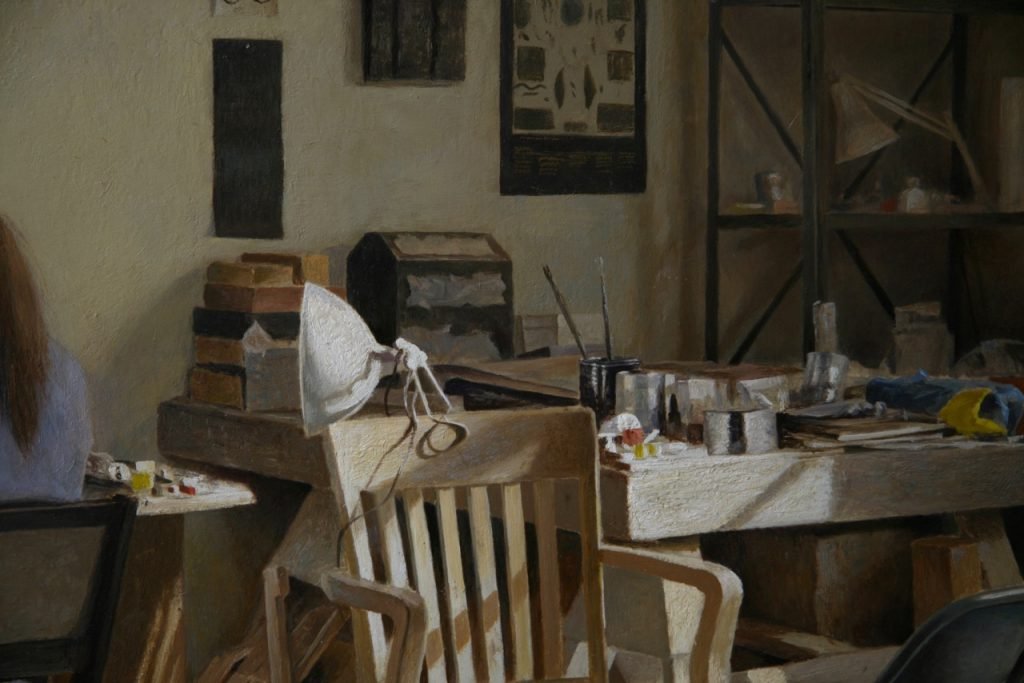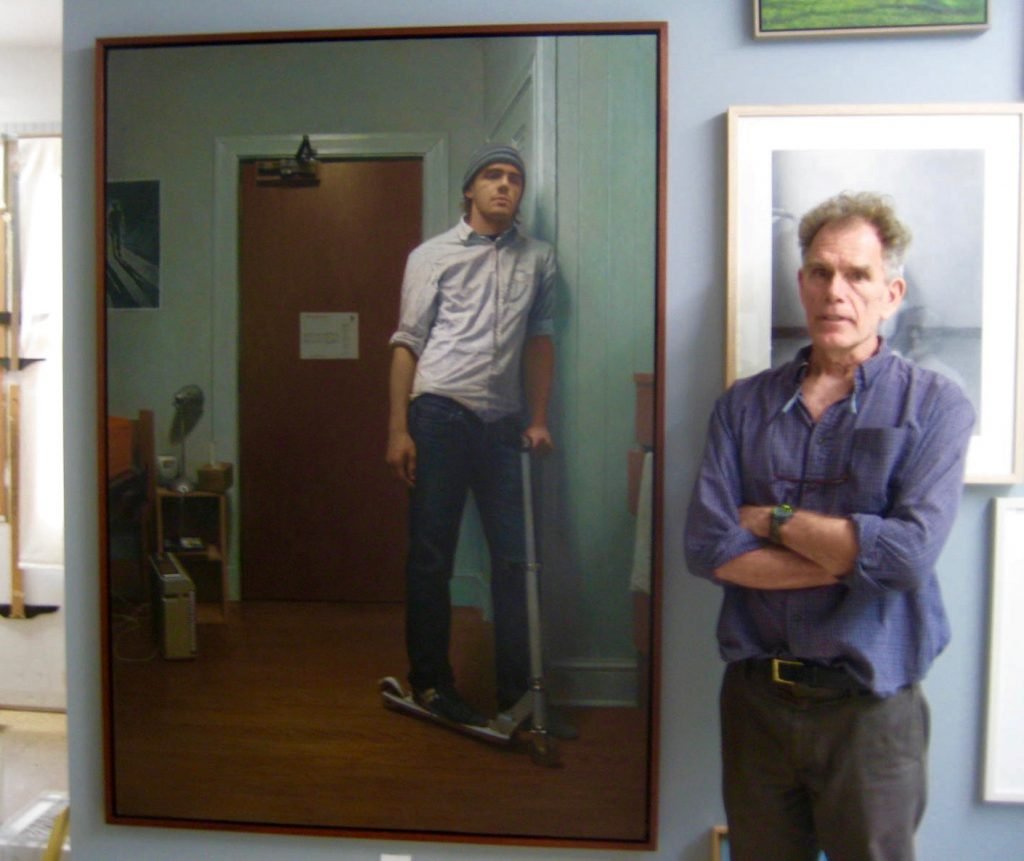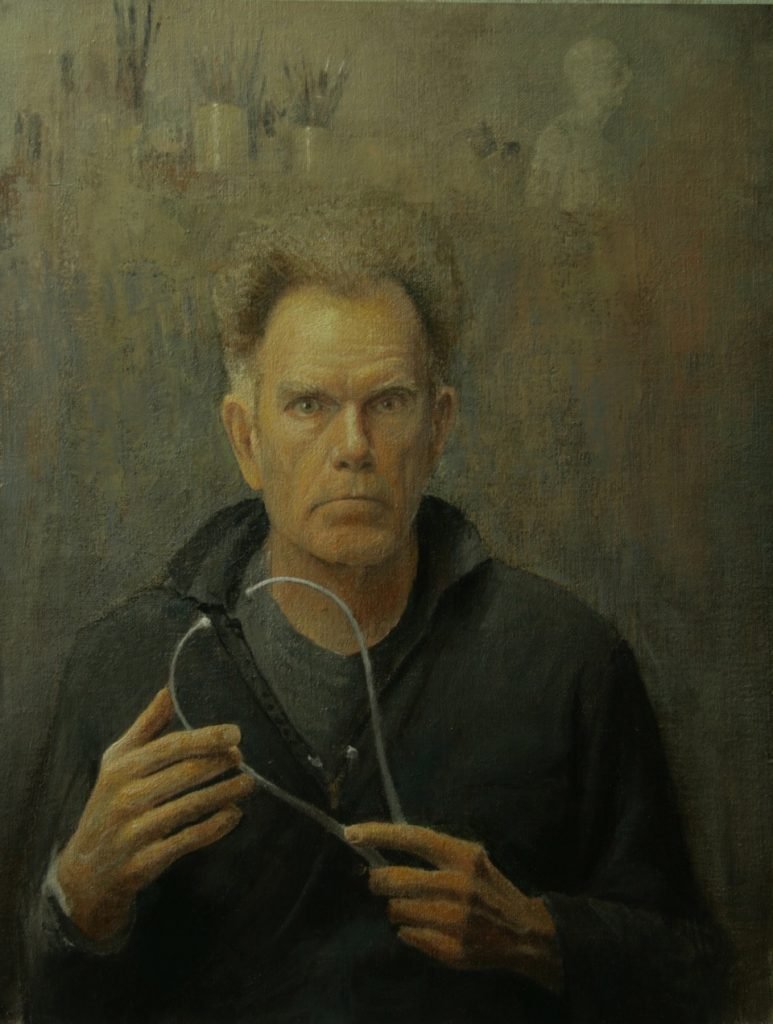
Whether nature, still lifes, intimate interiors or portraits, John Randall Younger aims for the sense of reality rather than an exact, perfect replica.
“I paint more illusion of reality,” says Younger, two-time finalist of the Outwin Boochever Portrait Competition at the Smithsonian National Portrait Gallery. “If you saw me paint you’d think ‘what’s he doing.’ I use palette knives and old cheap brushes. I scratch the canvas. I don’t fuss.”
Younger is the son of eminent wildlife artist Richard E. Younger, illustrator of McClane’s Standard Fishing Encyclopedia. “My father did botanical representation. He would paint every hair. He would count the scales on a fish. He was completely obsessive. It drove him crazy to see my work. He thought it was so sloppy. He would think this was a mess.”
The elder Younger moved his family from Missouri to Fort Myers, Florida for his illustrations. John grew up drawing well and was always interested in building and making things. Painting, however, was a challenge.
John studied drawing and sculpture for a year at the Portland School of Fine Arts in Maine. When the School changed directors and moved more to the abstract and conceptual, he was not interested. “I wanted to learn how to paint,” he says from his secluded studio in Ivy, Va. “Painting is a different mindset.”
Younger soon began selling his drawings and portraits while experimenting on his own. In teaching himself to paint, he researched paint formulas for different mediums. “I love the surface,” he says. “To me that is what’s magical about painting.”
And John studied the experts. “For years it was just the Old Masters—Rembrandt, Vermeer, the Dutch interiors. I was always interested in learning how they did it. I was lucky when I turned 18, I got to go the Rijksmuseum in Amsterdam. It really influenced me to see the works in person. Until then, I hadn’t been exposed to a lot of art.”

Younger was also a young admirer of Andrew Wyeth. Today he likes “looser” and more abstract painters—Richard Diebenkorn, Picasso, the moderns. “I find them all interesting. I like Sargent too. He just painted all the time, and let everybody else worry about what it means.
“The challenge is to keep the realism, but also the abstract quality of the aesthetic of the painting. I like to go for the composition first. It’s not based on reality per se. I observe from life and then I move things around.”
“John Randall Younger’s work is principally concerned with the latent essence of places, objects and people,” notes Deborah McLeod, Executive Director of the Piedmont Council of the Arts and Director of the Chroma Gallery in Charlottesville. “There is nothing extraneous in his renderings because the artist draws out so much purity and genuine honesty from each of his subjects, as if to paint their or its secret life or dormant meanings. His style belongs somewhat to realism and yet the result is beyond the notion of ‘real.’ It is rather more its immaterial manifestation.
“Younger reveals this through the quiet, porous surfaces of every plane. He employs an ancient technique called scumbling, a tonal softening process involving the thin application of repeated semi-opaque colors, applied with a dry brush. The result is a complex, almost cellular surface that seems alive and breathing.”
While not rendering every minute detail, Younger begins with extensive drawings and smaller oil studies that he usually expands onto larger canvases. “I start out with the germ of an idea—something strikes me, like the light. I try to just paint and let my unconscious come out. The paintings rarely end up they way I intended.”

John was only 22 when he painted Peonies. “I was then a very descriptive painter. This technique was closer to drawing than painting. I am more painterly now.”
Younger came to Virginia with his wife in 1980. Corporations were then moving into the state and creating a market for large panoramas. “I just happened to luck into that market and spent most of the 80s doing them. They’re all monsters. And in egg tempura no less,” he says.


In Clouds, Younger painted the water and wide skies of his Florida youth. “At the time I thought I was painting very realistically, and thought I was doing a good job. Now looking back, they look very stylized, unreal to me.”

“I’m done with panoramas. I try a few landscapes now and I just don’t have it. Who knows where I’ll wind up or when I’ll do it again.”

In the late 80s, Younger edged away from landscapes. Triple self-portrait was featured in American Artist Magazine in which he described his painting technique.
Younger soon narrowed his vision, intrigued with interiors and intimate views that included figures, some mysterious and only seen from the back. Again, he enlarged studies and sketches, adding and subtracting elements as he went. “They are very much from imagination, but looking back on them, they look surreal.”

NYC apartment was one of his first attempts at building an interior with figures. “I recreated the scene in my studio. Then I moved the figures around, and changed the lighting. It’s intentionally somewhat chaotic. The challenge for me is to keep the realism but also the abstract quality of the painting’s aesthetic. I keep working on it. It’s never really finished.”

Perfecting his elegant and somewhat secretive interiors, Younger was a finalist in the 2006 Outwin Boochever Portrait Competition of the Smithsonian Museum in Washington, DC. As a finalist, his 6 a.m. hung for a year in the National Portrait Gallery.
“After I painted it, I noticed there’s a stairwell and a door that goes down to the basement and thought, ‘wow, I put that in there.’ I realized there was some sort of up and down meaning. The figure was sort of floating. The way she’s posing, she looks almost like a ghost.
“I just love interiors…the meaning of doors and windows…I’m intrigued by them. We live in these boxes, but then when you put all these things in a painting, they have meaning. I don’t have any deep thoughts, I just paint,” he says.

In 2009, Younger’s work, Suzanne, was again chosen as a finalist in the Smithsonian’s highly competitive contest. He’s first to have two works from the contest exhibited at the National Portrait Gallery.
The subject, Suzanne Silver, was an artist with whom Younger shared a basement studio at Charlottesville’s McGuffey Arts Center. “Every morning we were both there early,” he says. “Suzanne would take all this raw material, all this junk she’d find in dumpsters, and she’d sit there and sew and make these beautiful statements. This little factory. She sat there all day doing that. It made me self conscious because that’s what I do all day. Artists just sit all day with their backs to the world.
“The strangeness of her position intrigued me and was the impetus for the painting. The discarded junk in the room was rearranged almost daily as she slowly transformed the objects into her art. My identification with Suzanne was a strong force behind the work. As the painting progressed, possible themes became apparent, but only in retrospect can I honestly see them. My concern while painting is simply to resolve the mundane problems I face with the medium; through that long, difficult process, the painting (hopefully) takes on a life of its own. Looking back, I think that is what the painting is about—the banality and ecstasy of the artistic process.”
Younger’s once critical father was delighted with his son’s success. “When I got into the National Portrait Gallery, he said, ‘That’s it, man!’ He was very pleased with that.”
His finely conceived and crafted paintings have been shown from the L.A. Art Show to Art in the 20th Century in New York U.S. Artists, Philadelphia and Art Chicago. He’s won the Allied Artists of America Award from The Butler Institute of American Art, Youngstown, Ohio, and the Award of Honor, Peninsula Fine Art Center, Newport News, VA.

Younger now concentrates primarily on portraits. His large portrait of his son, still in his studio, was painted during his son’s second year at Princeton. “It is kind of the way he was. The man-boy. He looked kind of strange. I think there are sexual undertones to it. They say every portrait is a self portrait, and I think I identified with my son at that moment.
“The light also interested me…that single light source…one dim bulb, disgusting, institutional lighting. The poster was one of his favorite movies, Stanley Kubrick’s A Clockwork Orange,” he says. “There’s so much unconscious motivation for painting, that’s why I’m wary of commentary. Sometimes a cigar is just a cigar.”

Between commissions, Younger likes to paint himself, a free and available model, he jokes. “If I get bored, I do self portraits. Painting mirror images, it’s reversed and it’s flat…being in reverse it’s never going to look like you to other people. Although my wife says, ‘That really is you…that intense, horrible look.’” He laughs easily.
“I am always working on several paintings at any given time. That’s the future. I used to get criticism for being too eclectic, having too broad subject matter. Curators want a niche. But I get tired of a particular thing and I want to just move on and try something else. Just for the challenge.”
Visit www.johnrandallyounger.com to see more of Younger’s work.
— Elizabeth Meade Howard, art editor
Follow us!Share this post with your friends.
